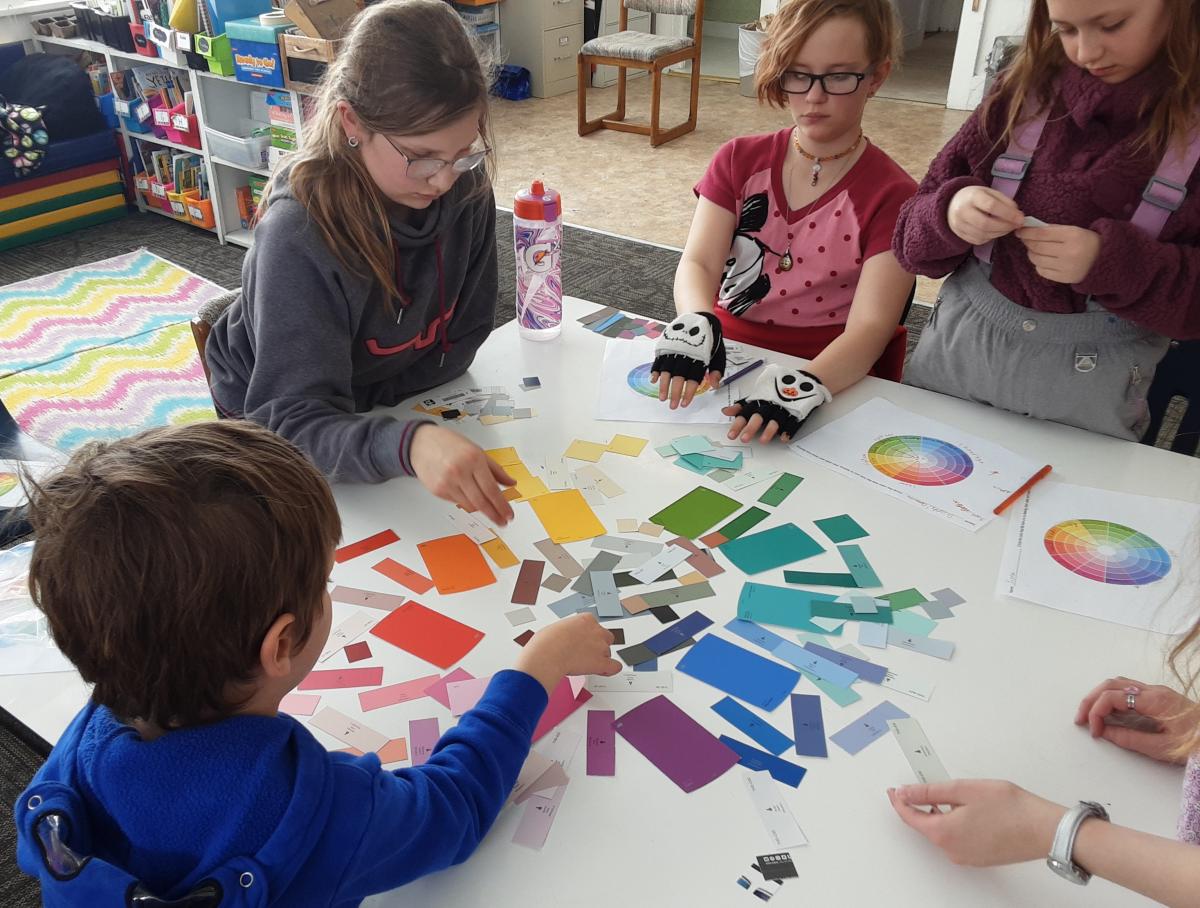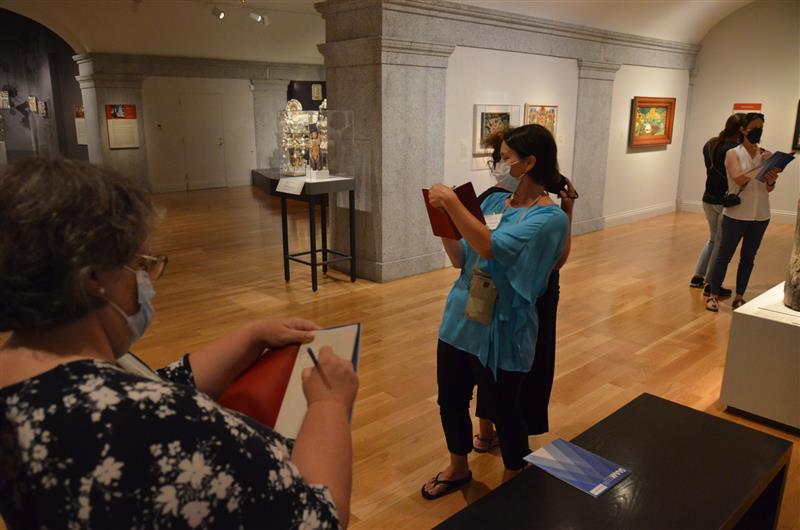As part of the Smithsonian, SAAM is both a local museum, inviting DC-area audiences into our beautiful galleries to learn with us, and a national resource, supporting learning and engagement across the country. In the Education Department, we have worked with students and adult learners nationally for more than two decades through our Artful Connections distance learning program. Over the years, we’ve had requests for virtual learning sessions from rural areas nationwide—from tiny islands off the coast of Maine where the population waxes and wanes with the seasons, to sparsely populated areas in Alaskan bush country where Native students learn with an emphasis on Tlingit language and culture, to communities in eastern Oregon which are so small they were once classified as “uninhabited” by the U.S. Census.
When the COVID-19 pandemic hit, however, our national education ecosystems struggled as never before, especially in remote areas. Rural school systems, students and teachers needed support. We pondered: How can SAAM help? How can we be pro-active in seeking to understand the experiences of learners in rural places, and create intentional learning experiences that meet their unique needs?
The answer became clear: a new learning initiative called REACH: Rural Engagement in Art, Culture and History. The goal of the REACH initiative is to engage with underserved rural communities to expand access to cultural programming and resources for students and teachers. We want to reach out beyond the Smithsonian walls and build partnerships with rural schools, lead programs for rural learners, create and distribute learning resources to communities, and build continuing relationships with rural constituents.
Where to begin? First, we looked at parameters to define “rural” for our initiative – is it based on geography? Population? Census-defined areas? Proximity to resources? All of the above? We quickly began charting a broad understanding of the many definitions of “rural” according to varied sources. Next, we listened. We set out to build a cohort of rural advisors, passionate educators from Montana, New Mexico, South Dakota, and Tennessee who are skilled community connectors. We heard about their experiences, challenges, and dreams. We engaged with rural teachers, education stakeholders, rural associations, and began to realize that awareness was key—most had never thought of the Smithsonian as a place to support learning in their communities. This was helpful to know so we market this initiative in a strategic manner, giving virtual info sessions and conference presentations at venues rural teachers routinely access.
What does a typical REACH education program look like? “There’s no one-size, fits all approach,” says Peg Koetsch, SAAM’s museum education specialist who manages the program. “Depending on the teacher’s needs, what students are learning, and where they are located, programs can take many forms.”
For a recent set of programs, Peg collaborated with a graduate student in Clinical Mental Health Counseling at the University of Montana in Missoula to focus on Social and Emotional Learning (SEL) with two one-room schoolhouses. Polaris School sits at the base of the Pioneer Mountains in rural southwest Montana and enrolls children from a small ranching community. Typically, three to eight students attend the school, and the teacher drives 90 miles round-trip daily. Wise River School serves PK-8 grades, and the current population consists of five students.
While analyzing artists’ choices in SAAM artworks, students delved into the emotional characteristics of color during live instructional videoconference sessions. They learned how to express their feelings both verbally and visually using a packet of colorful activities Peg had mailed to them. Students then created their own books based on what they learned. One student noted: “I want to grow up to be an artist.”
Responding to community needs is at the heart of this work, and we learned through our rural constituents of the need for both Spanish language materials and mental health resources to support social and emotional well-being. To meet content requests, SAAM distributed 1,175 bilingual teaching poster sets featuring Latinx social justice changemakers to rural classrooms in all 50 states. Working with Smithsonian Affiliations, we identified small regional museums with strong community collaborators to disseminate our bilingual Social and Emotional Learning Toolkits, with a focus on reaching rural populations and those without broadband access. Community recipients included students from a rural Head Start program in Madison City, Ohio; Spanish-speaking students from a Migrant School in rural Clark City, Ohio, whose families work in the agricultural fields nearby; three rural districts in Michigan; day campers on an Arizona ranch, and students from Fort Apache and San Carlos Indian Reservations, Arizona.
To support teachers, we recruited a cohort of rural teachers to attend our Summer Teacher Institutes in 2022, supporting them all with scholarships to travel to DC to spend days learning how to integrate American art into their curriculum. One rural teacher noted, “Because I am in the fortunate position of working with a number of teacher teams, across disciplines, I would love as many resources as possible to share. In fact, I am considering hosting after school professional development sessions where I could share with teacher teams all that I have learned this summer.” This is exactly the type of sharing and scaling we had hoped for through this initiative, and we look forward to seeing the results as the program continues.
While most of our REACH programming happens at a distance, sometimes remote connections do return to us locally. Recently, we hosted a group of students from a one-room schoolhouse located at the foot of the Sawtooth Mountains in Stanley, Idaho. After conducting pre-visit videoconferences with SAAM, six of their students and three teachers came from Idaho on a school trip to Washington, DC, and had a special before-hours tour of SAAM’s galleries focused on U.S. history and how to interpret art. For some students, this was their first trip outside of their town. A friend of the school noted: “It certainly will not be the biggest tour you have ever designed, but it may be the most appreciated of all time! The previous teacher has tried for years to get the state to fund a trip to the SI to no avail. This year finally it will happen and it sounds as though REACH is the answer.”
As the school year winds down, we reflect on the many ways REACH has touched remote learners nationwide – from discussing civil rights with 5th grade students in rural Hawaii, to co-creating an online professional development course for teachers in New Mexico, to collaborations with the Nebraska and Tennessee Departments of Education. We look forward to partnering with the Smithsonian’s new rural learning initiative to leverage the broader, interdisciplinary power of our collective art, science, and history museums and expand our REACH.
Are you an educator or learner in a rural community? We want to hear from you! You can REACH us at AmericanArtEducation@si.edu.




















